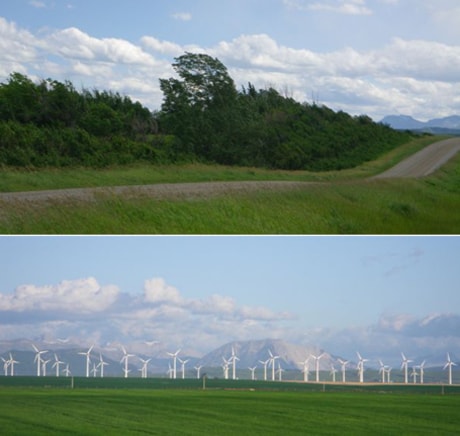Who has seen the wind?
Neither you, nor I:
But when the trees bow down their heads,
The wind is passing by. — Christina Rosetti
There are many things to love about our south, but the winds top our short list of dislikes.
Both Herself and I grew up in southern Alberta, and after we married and I was considering offers from Alberta law firms, wind ranked high on the reasons why we did not choose our roots.
But we return often, and this year arrived on a blistering hot early July day at the family ranch west of Pincher Creek. That evening, the winds hit, and all night the house sounded like someone was throwing bodies around.
On the early morning paper run to town, not one deer did I see in all the usual spots. Deer hate high wind, and hole up until they’re sure its over.
At breakfast, wind howling harder than ever, sister in law, Caroline, asked what I would be doing with my day.
“Photographing the wind,” I replied, not realizing then what a technical and philosophical challenge that would be.
Fishing was doubtful because the rivers and streams were still dangerously high and murky. But even in my able-bodied days, I would not have risked such waters plus barn-rolling winds.
Before leaving for the Crowsnest Pass, I checked Gopher Heaven and was astonished to see that dozens of Caroline’s personal plague of rodents were not sensibly in their holes, but standing tall, letting the surf of wind-blown grasses flow around them. They need thinning, but not by shooting in a gale with $2 a shot premium 40 grain .22-250-calibre ammunition. So I shot some with a camera instead, but the wind is just not there with a still camera.
At his Crowsnest Angler in Bellevue, Vic Bergman, a fine photographer, allowed that he’d never thought of trying to photograph the wind. Vic’s first guided trip of the season was out that day, July 8th, a walk and wade to Lynx Creek, instead of the planned Castle River float, because the Castle is still too high and muddy.
Losing four to six weeks of a season is hard on our fishing guides and outfitters, but they are better off than in Montana, where it is now thought that half to three quarters of the state’s important guided fishing business will be lost this year to high waters caused by abnormally heavy snow pack and persistent spring and early summer rains.
Our own hard winter caused some winterkill in some Crowsnest Pass area lakes. Hit particularly hard was Summit Lake, just on the B.C. side of the border, the most convenient place for Alberta anglers (this side of Diefenbaker Lake) to fish for huge triploid rainbows.
Vic Bergman told me that Summit was not totally winter-killed and has recently been re-stocked. I could not photograph the wind-waves-surf at Summit, which seemed to be somewhat sheltered. Two anglers reported no action, and nary a fish rose while I was there.
From one vantage point there was a great scenic of waves of tall grass flowing toward Crowsnest Mountain and windblown clouds scudding past its peak, but again, without the motion, the wind is absent.
On our side of the Pass, the power had blown out. Lunch was on anyway, at Vito’s in Coleman. I understand no chilled beer glasses and cash only at the till, but not how they put good stuff together — particularly arrange those great pizzas — back in that dark kitchen.
On the back way, the scenic route along Hwy 507 to Beaver Mines and Pincher Creek, Lee’s Lake had a high sea running with the wind and a couple of intrepid belly boaters out in it and doing a brisk business with the rainbow trout. For one of them, the ordinarily complex business of landing and getting up and out of a belly boat was further complicated just as he was doing all that, by his hooking a large rainbow.
Back at the ranch, the old barn was still standing, but a chunk of it had blown off and taken down the power line to the pump house on the creek. Dinner was delayed while we awaited the arrival and services of the electrician. No matter, we had frozen water in small chunks, frosted glasses, plus liquids other than water to keep our electrolytes up.
A dead stillness woke me at 5:30 a.m., so I got up and headed out, intending to photograph deer feeding everywhere after being bedded so long. Nothing, all the way to town: which had to mean that we were merely enjoying a lull, and the deer weren’t fooled. Sure enough, the wind was raging again when I got back to the ranch.
On the next still morning, as we were leaving for home, I saw only the third deer of the three days.
Bob Scammell is an award-winning outdoors writer living in Red Deer.
